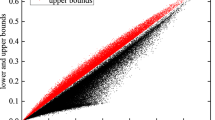Abstract
In many theoretical proposals appeared recently, semidefinite programming was considered as a way to express quantum entanglement. Using semidefinite optimization method, we prove the Lewenstein–Sanpera lemma in a simple elegant manner. Particularly, using this method we obtain Lewenstein–Sanpera decomposition for some examples such as: generic two qubit state in Wootters’s basis, Iso-concurrence state, Bell decomposable state and 2 ⊗ 3 Bell decomposable state.
Similar content being viewed by others
Explore related subjects
Discover the latest articles, news and stories from top researchers in related subjects.References
A. Einstein B. Podolsky Rosen (1935) Phys. Rev. 47 777 Occurrence Handle10.1103/PhysRev.47.777
E. Schrödinger (1935) Naturwissenschaften 23 807 Occurrence Handle10.1007/BF01491891
M. Lewenstein A. Sanpera (1998) Phys. Rev. Lett. 80 2261 Occurrence Handle10.1103/PhysRevLett.80.2261
B. G. Englert N. Metwally (2000) J. Mod. Opt. 47 2221 Occurrence Handle10.1080/095003400420076
S. Karnas M. Lewenstein (2001) J. Phys. A. Math. Gen. 34 6919 Occurrence Handle10.1088/0305-4470/34/35/318
T. Wellens M. Kus (2001) Phys. Rev. A. 64 052302 Occurrence Handle10.1103/PhysRevA.64.052302
M. X. Goemans D. P. Williamson (1995) ArticleTitleImproved Approximation Algorithms for Maximum Cut and Satisfiability Problems Using Semidefinite Programming J Assoc Comput Mach. 42 IssueID6 1115
Z. Q. Luo (2003) ArticleTitleApplications of Convex Optimization in Signal Processing and Digital Communication Math. Program. Series B 97 177
T. N. Davidson Z. Q. Luo K. M. Wong (2000) ArticleTitleDesign of Orthogonal Pulse Shapes for Communications via Semidefinite Programming IEEE Trans. Signal Proces 48 IssueID5 1433 Occurrence Handle10.1109/78.839988
W. K. Ma T. N. Davidson K. M. Wong Z.-Q. Luo P. C. Ching (2002) ArticleTitleQuasi-Maximum-Likelihood Multiuser Detection Using Semidefinite Relaxation with Application to Synchronous CDMA IEEE Trans. Signal Proces. 50 912 Occurrence Handle10.1109/78.992139
S. Boyd, L. El Ghaoui, E. Feron, and V. Balakrishnan, Linear Matrix Inequalities in System and Control Theory. Society for Industrial and Applied Mathematics (1994).
A. C. Doherty P. A. Parrilo F. M. Spedalieri (2002) ArticleTitleDistinguishing Separable and Entangled States Phys. Rev. Lett. 88 187904 Occurrence Handle10.1103/PhysRevLett.88.187904 Occurrence Handle12005725
P. A. Parrilo, A. C. Doherty, and F. M. Spedalieri, Entanglement Witnesses and Semidefinite Programming, in Proceedings of the 41st IEEE Conference of Decision and Control (2002).
L. Vandenberghe S. Boyd (1996) SIAM Rev. 38 49 Occurrence Handle10.1137/1038003
L. Vandenberghe S. Boyd (2004) Convex Optimization Cambridge University Press Cambridge
S. J. Akhtarshenas M. A. Jafarizadeh (2004) Phys. A: Math. Gen. 37 2965 Occurrence Handle10.1088/0305-4470/37/8/008
A. Peres (1996) Phys. Rev. Lett. 77 1413 Occurrence Handle10.1103/PhysRevLett.77.1413 Occurrence Handle10063072
M. Lewenstein, Quantum Information Theory, Lecture Note (2001).
W. K. Wootters (1998) Phys. Rev. Lett. 80 2245 Occurrence Handle10.1103/PhysRevLett.80.2245
S. J. Akhtarshenas M. A. Jafarizadeh (2004) J. Phys. A: Math. Gen. 37 2965 Occurrence Handle10.1088/0305-4470/37/8/008
S. J. Akhtarshenas M. A. Jafarizadeh (2003) Quantum. Inf Comput. 3 229
M. Horodecki P. Horodecki R. Horodecki (1996) Phys. Lett. A. 223 1 Occurrence Handle10.1016/S0375-9601(96)00706-2
N. Linden S. Massar S. Popesco (1998) Phys. Rev. Lett. 81 3279 Occurrence Handle10.1103/PhysRevLett.81.3279
A. Kent N. Linden S. Massar (1999) Phys. Rev. Lett. 83 2656 Occurrence Handle10.1103/PhysRevLett.83.2656
Author information
Authors and Affiliations
Corresponding author
Rights and permissions
About this article
Cite this article
Jafarizadeh, M.A., Mirzaee, M. & Rezaee, M. Derivation of the Lewenstein–Sanpera Decomposition via Semidefinite Programming. Quantum Inf Process 4, 199–218 (2005). https://doi.org/10.1007/s11128-005-5657-0
Received:
Accepted:
Issue Date:
DOI: https://doi.org/10.1007/s11128-005-5657-0
Keywords
- Lewenstein–Sanpera decomposition
- semidefinite programming
- Bell decomposable states
- Wootters’s basis and Iso-concurrence states




